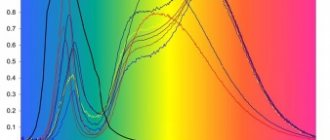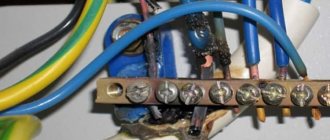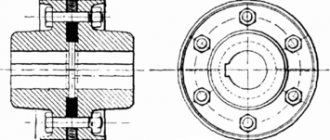Types of power lines by voltage
All electrical installations and power lines have an electromagnetic impact on the environment. The main impact parameter is the electric field strength, which shows the level of force around the wires in the power line area. Due to electromagnetic radiation, lines of force arise in the space around power lines, which, when crossing any conducting medium, can induce an EMF in it. As a result, an unusual potential appears on any object, and in the presence of a closed circuit, electric current will flow.
However, the electromagnetic field strength is not uniform in space - the intensity decreases as one moves away from the power line. In addition, the gradation of harmful effects largely depends on the rating of the transmission line.
Therefore, all power lines are divided into the following categories:
- Low voltage – supply voltage in which is up to 1 kV;
- Medium level – for lines from 1 to 35 kV;
- High voltage – ratings for 110, 154, 220 kV;
- Ultra-high – for ratings from 330 to 500 kV;
- Ultra-high – power lines with voltages of 750 and 1150 kV.
It should be noted that the effect of electromagnetic waves depends not only on the voltage level, but also on the strength of the electric current flowing through the wires. Therefore, the generally accepted standard establishes the optimal distance to live parts, which will be safe [ ].
How to determine power line voltage
When purchasing a plot, it is important to make sure that the distance to the overhead line - high-voltage line - is safe. Information about exactly what voltage is on a nearby power line is not always readily available. You can determine it yourself by the number of wires in the bundle and insulator disks near the pole.
A higher value can be determined by the number of wires in the cable bundle:
- 1 PC. — up to 330 kV;
- 2 pcs. — 330 kV;
- 3 pcs. — 500 kV;
- 4 things. — 750 kV;
- 6-8 pcs. - from 1000 kV and more.
Table of distances and voltages
You should not count the number of cables stretched between the supports, but the wires in one bundle. Additionally, you can navigate by the height at which they are stretched: the higher they are located, the greater the tension in them.
For lines with one wire, the voltage is determined by the number of insulators - ceramic disks in one cluster hanging from the pole. Regulatory figures are given in the list:
- 3-5 insulators - 35 kV.
- 6-8 insulators - 110 kV.
- 15 insulators - 220 kV.
On the streets within residential areas, power lines have a voltage of 6–10 kV, which does not create radiation exceeding a value that is safe for humans. These wires are brought into houses, passing over the fences of the plots.
Distances from the fence to buildings on the site
Standards for safe use have also been developed for them. According to SNiP, residential buildings and other buildings must be located no closer than 5 m from the red line. This is the front boundary of the site. All underground and overhead communications pass through it, including power lines. Only a wire connected directly to the building violates the safe distance.
The insulator on which the wire is attached externally must be located on the wall of the building at a height of 2.75 m or higher. The entrance to the house should not be located above or next to bedrooms, children's rooms and rooms where the family spends a lot of time. The best option is the wall of a pantry, utility room, or hallway.
The minimum sag of self-supporting insulated wires above the pedestrian path is 3.5 m. The sag of the wire between overhead line poles must be more than 6 m from the ground above the roadway.
In the private sector, the power line runs along one side of the street - the red line on the plan. The distance from the power line to a private residential building on individual housing construction land must strictly comply with the PUE standards. Wires to connect the house from the opposite side must only be pulled through additional supports. The height to the insulators exceeds 6.2 m. The minimum distance from 6 kV power lines to trees is 2 meters horizontally.
Pole installation diagram
- To understand how dangerous it is to live near a power line and what the safe distance from a power line is, you need to carefully consider it. The minimum voltage is 0.4 kV; such lines are equipped with small transparent insulators and five wires.
- 10-kilovolt lines have much larger insulators (only 1-2 of them) and three wires.
- A 35-kilovolt power line has a wire attached to each of the three insulators.
- A 110-kilovolt line has 6 insulators on each wire.
- And the 150-kilovolt line is from 8 to 9. Next come the lines through which electricity is supplied to the substation, their voltage is 220 kV, and here the number of insulators reaches 40.
- In the most powerful lines (330-750 kV) the number of wires is from two to five, insulators - from 14 to 20.
Distance
Safe distance from power lines to a residential building
Since it is not practical to reduce the transmitted voltage, a so-called sanitary zone is established around the lines, establishing a minimum distance from the area where the high-voltage line is located.
Thus, according to clause 4.1 of SanPiN 2971-84, the following parameters can be distinguished:
- For 330 kV lines - the distance must be at least 20 m to the nearest buildings;
- For power lines with a nominal value of 500 kV, it is necessary to maintain a distance of up to 30 m;
- For overhead lines with a voltage of 750 kV - at least 40 m;
- A distance of more than 55 m is allowed from the supports of 1150 kV overhead lines.
Figure 1: safe distance from power lines
The remaining electrical installations are relatively safe, since the design distance established by building regulations and the size of the security zone should be quite sufficient. Despite these standards, in some cities dangerous radiation also covers other high-voltage ratings; for example, in Moscow it is prohibited for buildings, gardens and garden plots to be closer than 20 m to a 110 kV overhead line.
However, scientific research abroad leads scientists to the opinion that the above values are insufficient for human safety, therefore, in a number of countries they are guided by the power of power lines, which takes into account not only the electrical, but also the magnetic component. In European countries, an expanded danger zone is applied to the distances to power transmission line wires, 4 to 10 times larger than in the post-Soviet space. This difference occurs due to the differentiation of the intensity of the impact of magnetic and electrical components on the human body.
At what distance should you not live near power lines: safe distance to live
At what distance should you not live near power lines:
- To avoid risks, the routes of electromagnetic fields that pass through such lines are delineated by sanitary protection zones. Their size corresponds to the voltage class and ranges from 20 to 55 meters (in Moscow these values range from 10 to 40 meters ).
- The distance is calculated from the wall of the house to the wires. Within these zones, the construction of housing, summer cottages, public buildings, as well as the location of gardens and vegetable gardens is not allowed.
- These values do not take into account the magnetic field surrounding the power line. Therefore, experts recommend that to fully guarantee safety, consider the distance to be ten times the specified standards.
- For example, the distance around low voltage lines within a radius of 100 meters is a completely sufficient sanitary protection zone. The fact is that there are no official data regarding harmful emissions from power lines, so you should focus on the standards established by documents and your own well-being.
Opinions vary about how dangerous it is to live near power lines . Those who consider them dangerous cite statistics of deaths in areas where high-power power lines pass to prove that they are right. Doctors do not completely agree with this statement and refer to their own indicators and calculations.
Opinions about the harm vary
The truth, as usual, is in the middle: constantly being near the support of a 750-kilovolt line, it is quite possible to feel unwell. If the contact with the power line is not constant and the correct distance from it is maintained, the body is unlikely to react to the influence of the electromagnetic field.
Harm to human health
It should be noted that all electrical devices can have harmful magnetic and electrical effects on the human body, which can lead to both deterioration of health and exacerbation of chronic diseases. Some of the recent studies by Kosov A.A. and Barabanov A.A. , the role of electromagnetic fields and radiation in the human security system confirmed the direct dependence of most biochemical reactions on the level of externally induced voltage. In turn, powerful power lines have a much greater impact, so a standard for approaching the source has been established.
Figure 2: Electric field strength differences with distance
So, depending on the location, it is allowed:
- In populated areas, the voltage is no more than 5 kV/m;
- At intersections of highways and pedestrian roads up to 10 kV/m;
- Outside populated areas no more than 15 kV/m;
- In hard-to-reach places (mountains, forest belts, etc.) up to 20 kV/m.
If the above values are not observed during the construction or operation phase, power transmission lines may be relocated. In other cases, prolonged exposure to magnetic radiation of 0.5 kV/m is allowed.
However, there are a number of situations when, when performing technological processes or operations, a person may come close to or be directly in powerful electromagnetic fields. In this case, a restriction on the time spent near overhead line wires or supports is introduced for different voltage levels:
- At 5 kV/m – the duration of stay during the shift is not regulated;
- At 10 kV/m - the residence time should be no more than 3 hours;
- At 15 kV/m – no longer than 1.5 hours;
- At 20 kV/m – no more than 10 minutes;
- At 25 kV/m – no longer than 5 minutes.
If such standards are observed for staying near power lines, the human body recovers naturally within 24 hours, the chemical composition of the blood and the condition of the internal organs return to normal. If the duration of exposure to magnetic lines is longer, then shielding and special protective equipment are used.
Rice. 3. An example of human protection from electromagnetic radiation
About the dangers of power lines on the human body
Date: April 28, 2010 |
Category: Articles Tags: Power lines, power lines, Power lines This material was prepared by specialists. Do you need electrical installation or electrical measurements? Call us!
There is a lot of talk about the dangers of high-voltage power lines, and most often in vain. Whatever theories have been put forward about how power lines affect a person, statistics on the incidence of cancer in people living in an area with a nearby high-voltage line, the influence of power lines on brain cells, and even widespread hair loss are associated with closely located high-voltage lines. Let's try to understand this issue and justify what is said but never proven.
So, only two types of radiation can come from power lines, in the form of a static field and alternating waves. In addition to high-voltage lines, the same radiation is produced by electrical wiring and any of the electrical appliances in our houses and apartments. For comparison, let's take one AC outlet with a voltage of 220-240 volts, located a meter from a person, and a power line with a voltage of about 200 kilovolts, located at a distance of 30 meters. The strength of the static field becomes smaller in proportion to the square of the distance, so both radiation sources, the outlet and the power line, have approximately the same effect.
In the case of alternating waves, the attenuation occurs much weaker, since their strength is inversely proportional to the distance from the radiation source, and if we take the same distances as in the previous case, then the equivalent of an outlet located a meter away from us will be a power line with a voltage of 6. 5 kilovolts. Please also note that in our home there is not just one outlet, but also meters of electrical wiring, a refrigerator, a TV, a computer, and a bunch of other electrical appliances, and their radiation will be much stronger.
It is impossible to say that high-voltage power lines have any harmful effects on the human body. The fact is that this issue has never been fully studied. In theory, the only thing that a nearby power line can cause in the body is resonance of internal organs. However, the industrial frequency of the current is 50 Hz, and there is no such frequency in the human body; lower frequencies influence us. However, people who work with high voltage, including high-voltage power lines, have noted that they experience chronic fatigue syndrome, irritability, and weakened immunity. It is quite possible that the listed symptoms are due to the fact that work with high voltages requires constant composure and attentiveness, in contrast to other jobs, when increased attention is required only periodically.
The issue of the dangers of power lines will remain unstudied for a very long time, and the point is not that there are people for whom it is important that this information remains sealed, although this may well be the case, the point is that Each person has a very different perception of both electromagnetic fields and static radiation from high-voltage lines. In some countries there is even the concept of “electrical allergy”.
People who are especially sensitive to radiation from electrical appliances and high-voltage lines have the right to move to a greater distance from passing power lines. By the way, all costs and search for housing are borne by the government. In our country, the maximum money was spent on was to develop standards according to which high-voltage lines are installed. Residential buildings should be located no closer than 10 meters for a line of 35 kilovolts, 50 meters for 110-220 kilovolts and 100 meters for 330 kilovolts and above. The distance is calculated from the outermost wire to the wall of a residential building.
Another interesting fact: living next door in the same house, two people of the same age can experience different effects from power lines passing nearby. For one it will have a depressing effect, while for another, on the contrary, it will feel a surge of vigor and strength.
It turns out that indeed high-voltage power lines affect people differently. Perhaps this is precisely what is slowing down research in this area? Although it is quite possible that in reality there is no powerful influence at all, and in both the first and second cases it is simply self-persuasion.
At the moment, there is no evidence that power lines are harmful to humans, however, nothing has been written about their harmlessness. Indeed, what is known for certain is that they have a certain effect on the human body, but how detrimentally it affects us remains a mystery.
However, supporters of the opinion that high-voltage lines destroy the human body annually publish dry mortality statistics in areas where powerful power lines run. Sanitary services, in turn, claim that high-voltage power lines are harmless and provide physical calculations. If you look at this problem sensibly, without giving preference to one side or the other, then you can draw certain conclusions. For example, a drop of water cannot kill a person, but if it methodically drips on his head, then very soon the person goes crazy.
If you spend your whole life under the support of a power line of 330 kilovolts, then naturally there will be a very significant effect of its radiation on your body, but if you are constantly away from power lines and only periodically come into contact with the radiation emitted by them, then you will not see any changes in your body notice.
That is why, if possible, try to get out of the city, at least occasionally, because our cities have long become a kind of energy cesspools, where electromagnetic, static and many other types of energy fields intertwine. In some places, influencing each other, they weaken, in others, overlapping, they intensify many times and no longer meet sanitary standards at all. It is virtually impossible to protect yourself from them, but giving your body a break from their effects is available to almost everyone.
Other and useful information
Other and useful information
Impact on the environment and ecology
In addition to the impact on humans, harm from power lines also affects other living organisms. Thus, plants growing near power line supports and along the entire length of high-voltage wires begin to change. In some cases, the deviation of shoots and branches away from the line is clearly manifested, in others, branches atypical for a particular type occur, changes in the structure of the plant, etc. However, at the same time, some agricultural crops and fruit-bearing trees under the influence of power lines produce better yields and increase the formation of seeds.
Representatives of the animal world feel the impact and harm from passing power lines and try not to approach them at an unacceptable distance, sticking to pastures away from the lines. Electromagnetic radiation poses a particularly significant danger to artiodactyl fauna, since the hooves represent a layer of insulation that prevents the charge from flowing to the ground. Because of this, a significant potential can be induced in the animal’s body, which will be discharged at the first touch to the grass or tree leaves.
Rice. 4. Impact of power lines on artiodactyl animals
In relation to insects, a particularly strong reaction is observed between power lines and bees. Since in the case of the location of the hives directly below the line, the activity of individuals, honey collection and offspring are significantly reduced. In some cases, the death of queens that do not leave their habitat is observed.
How to protect yourself from electromagnetic radiation
As you move away from the power line, the magnetic radiation decreases. SanPiN indicates the distance when it reaches an acceptable value, but does not disappear completely. Experts say that a completely safe distance is 10 times the permissible distance.
Additionally, the house has wires and electrical appliances. During operation, they also emit electromagnetic waves at a distance of up to 2 meters from the compressor and heating elements.
The most dangerous are irons and refrigerators. People receive the most radiation from televisions because they spend a long time in front of them. As a result, all radiations are summed up, and a value exceeding what is safe for humans is obtained.
We invite you to read: Dismissal during a probationary period at your own request
Houses located at a distance of closer than 100 meters from lines with household voltage and 200 meters from high-voltage lines must be protected from electromagnetic radiation.
On the Sunset
It is necessary to take into account
The location of buildings should be taken into account during construction and the façade should be immediately screened. In already built houses, especially old ones located near high-voltage lines, it is necessary to make repairs and partially protect them from the external magnetic field.
The roof must have a metal roof. The walls are covered inside with steel mesh. It is laid on the surface of the wall under the plaster.
Secured territory
It reflects and absorbs radiation better than brick. In this case, the roof and wall grid must be grounded.
Inside the house, it is necessary to install sockets with grounding to include all energy-intensive appliances. The grounding structure can be made in one way:
- At a distance of 5 m, mark an isosceles triangle with sides of 2 m.
- Dig a ditch around the perimeter 20–25 cm deep.
- Hammer rods with a diameter of 10–12 mm into the corners. Their length is 2 m.
- Connect the pins with an iron strip 20 mm wide. Its thickness is at least 1.5–2 mm. Weld the strapping to each pin or attach it with bolts, having first cleaned the contact points from scale and dirt.
- Weld a strip of metal to the contour and guide it through a ditch 20 cm deep into the house.
- Fill all trenches with soil.
Wiring throughout the house should be done according to the design calculations. All wires from phase 3 should be routed and connected to a terminal block welded to the grounding strip.
Distance from tap to pole
The permitted distance from supports, the requirements of SanPiN and SNiP must be observed when building a house and utility rooms. Moreover, these are the same rules both for houses in the city and for buildings in SNT and individual housing construction located in the countryside or in rural areas.
Harm to technology and means of communication
Also, damage from power lines is observed at nearby electrical installations; overhead line devices and communication lines are especially susceptible to the influence. Obvious harm for them is expressed in the induction of excess potential at frequencies close to or equal to the frequency of signal transmission. What causes interference or distortion of transmitted data. For devices in a grounded metal casing, the damage to power lines will be insignificant, since the outer casing acts as a natural shield.
A separate issue is the damage caused to underground communications, in particular pipelines. In the case of close proximity of power lines, an EMF occurs on the conductive surface of the pipeline, causing metal removal and premature corrosion destruction. In addition, an underground electrical pipe can cause electric shock to a person. Therefore, they are also trying to secure them with the help of UZTs, which provide safe underground crossings or parallel laying along power lines.
Bottom line
Having studied the above material, we can summarize that the presence of a person near lines with voltages above 1 kV not only affects a person’s well-being, but can also cause significant harm to his health. Therefore, in case of forced stay near high-voltage power lines, a person must minimize his time in dangerous areas.
If the line is located in close proximity to your home and you are not sure of the safety of the proximity to the power line, then specialized measurements should be made. Which can be performed by organizations with the appropriate level of qualifications and equipment. They will check the compliance of the electromagnetic background in your home with sanitary standards.
Sources used:
- https://www.elibrary.ru/item.asp?id=35368561
- https://www.niehs.nih.gov/health/topics/agents/emf/
- https://publications.iarc.fr/98
Magnetic radiation from high voltage lines
When electrons pass through wires, they create an electromagnetic field around their carrier. Depending on the type of current, the radiation value is constant or variable. A continuous change in the current value from plus to minus and vice versa causes the field to change its value 2 times more often.
Exposure to magnetic radiation negatively affects a person’s physical condition, just like exposure to radiation.
Research on the effects of electromagnetic radiation on humans and wildlife began to be carried out at the end of the 70s.
Based on the results of a survey of people in different countries, the WHO - World Health Organization determined the maximum permissible radiation levels in hertz per unit of time. In the Russian Federation and other countries, regulations have been developed prohibiting industrial and civil construction at close distances from power lines.
People who spent a long time in a strong field zone were diagnosed with cancer and heart disease. Women suffered from infertility. Men were plagued by pathologies of the genitourinary system. General weakness appeared. Life expectancy was reduced.
Cheap land near the protected zone
Based on SanPiN standards, construction rules were developed and sanitary zones were created under high-voltage lines. Children's institutions located in the danger zone must be closed. It is prohibited to build residential buildings for permanent and temporary residence closer than the distance indicated to high-voltage lines in SanPiN 2971-84.
It is impossible to sell a house located in a dangerous area. Sanitary and fire safety organizations will not approve such a document. When developing individual housing construction sites, it is necessary to take into account the distance to the power lines located nearby.
How dangerous the radiation from high-voltage lines is is demonstrated by land prices. The cost of plots near power lines is low. As you move away, it rises every 50 m. You shouldn’t be tempted by the cheapness. You need to think about the health of your family.
Width of sanitary zone
The safe distance from power lines is measured perpendicular to the axis of the overhead line - the high-voltage line. The projection of the outermost wire onto the ground or the outer point of the support structure is taken as the starting point. The width of the sanitary zone depends on the voltage in the wires and is determined by SanPiN 2971-84. Background radiation is measured at a level of 1 meter above the ground.
You cannot build, plant or stay in the sanitary zone for a long time. Land under power lines is prohibited from being sold or used for commercial purposes.
Safe distance to power lines
The width of the sanitary zone does not meet the safe distance standards for housing construction. It is almost 2 times smaller, it is measured not from the outermost wires of the overhead line, but is indicated by one value centered on the axis of the power line. For example, the width of the sanitary zone of a 220 kV line is 25 m.
This is approximately 10 m from the support post in one direction. You can build next to power lines no closer than 25 m to the projection of the outermost wire onto the ground.
Below is the safe distance from the house to the power line depending on the voltage in the line:
- 20 kV - 10 meters;
- 35 kV - 15 meters;
- 110 kV - 20 meters;
- 150-220 kV - 25 meters;
- 300-500 kV - 30 meters;
- 750 kV - 40 meters.
Health hazards from power lines
A voltage of 10 kV is considered safe for humans. It creates a background density not exceeding 10 μT - microtesla. For comparison, the Earth's magnetic field is 30–50 μT.
It differs from the radiation generated by overhead lines in that it has a constant or smoothly varying value. A current with a frequency of 50 Hz passes through the power line - this means that per second the current changes its direction 50 times, a complete oscillation occurs - an alternating current wave. The value of the emitted magnetic field also changes with this frequency.
The highest value of natural vibrations reaches 40 Hz. When constantly in the zone of magnetic waves with high values, malfunctions occur in the human body.
This is possible not only when standing under power lines for a long time, but also next to household electrical appliances, especially thermal ones. The damage from the close proximity of overhead lines is commensurate with the harm to health caused by an iron, refrigerator, washing machine, or computer.
But if the voltage in the power line wires is higher than 35 kV and the apartment is located closer than the standard interval of the security zone plus 100 m, then, according to the health standards of the United Europe, such proximity can cause a number of diseases of the nervous, cardiovascular and immune systems.








